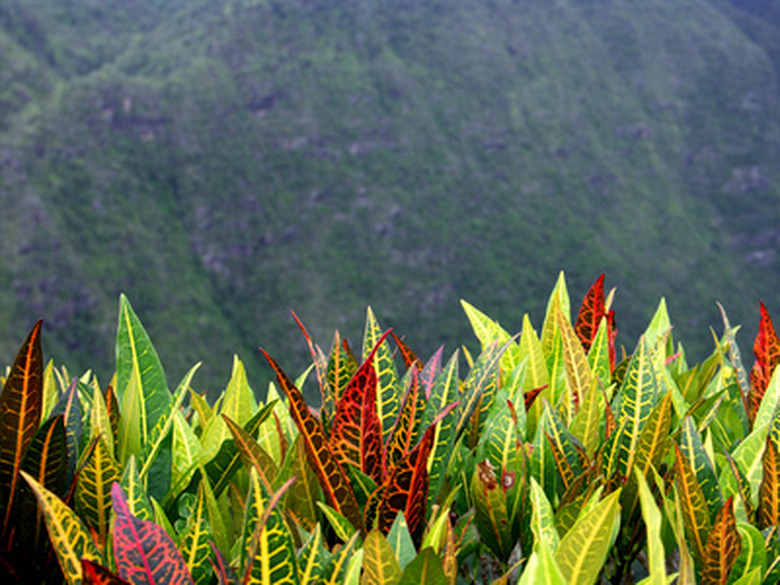Varieties Of Croton
Crotons are plants with glossy bright leaves that add color to a garden. These plants originally came from tropical regions such as Java, the South Seas Islands and Australia. Because crotons are vulnerable to cold temperatures, they only grow in warmer climates. They come in a wide assortment of colors and shapes with the different varieties based on their leaves, which include colors of yellow, orange, red, purplish-red and green.
Petra Crotons
Petra crotons, also known as "autumn plants," are the most popular type of crotons. They have showy leaves with waxy rainbow colors. These crotons grow upright and are known for being fuller than most crotons. Petras should not be watered with cold water because this can cause the plant's lower leaves to drop. Spider mites found on upper leaves are a problem.
- Crotons are plants with glossy bright leaves that add color to a garden.
- Because crotons are vulnerable to cold temperatures, they only grow in warmer climates.
Banana Crotons
Banana crotons are often grown in dish gardens. They need bright light to keep their coloration because they will turn green in low light. These crotons are thick plants that have long leaves of about 8 inches, according to the Web India 123 website. The various types of banana crotons differ in color. A popular variety is the "Majesticum" banana croton, which has long 10-inch linear leaves and yellow midrib veins that turn red as they mature.
Mammy Crotons
Mammy crotons are thick, colorful bushes that grow upright and have twisted leaves. They're an exceptionally colorful type of croton that's known for its twisted narrow leaves. Just as with most crotons, this variety needs direct filtered light during early morning hours and late day sunlight to keep its bright colors. The brightly colored leaves can attract spider mites so caretakers should look out for them.
- Banana crotons are often grown in dish gardens.
- The various types of banana crotons differ in color.
Gold Dust Croton
The gold dust croton, another bushy plant that grows upright, is a popular houseplant, particularly in South Florida, according to the Plant Care website. This variety, which gets its name from the gold specks on its leaves, is an exceptionally striking indoor plant for a home or office. It has dark green glossy leaves, but lacks flowers. Gold dust crotons need to be fed bimonthly with a balanced fertilized.
Norma Crotons and Oak Leaf Crotons
Norma crotons have colors that include pink, maroon, pale gold, orange and shades of green. Leaves from this croton come in various shapes. They can be grown both indoors and outdoors in gardens that are frost-free. Oak leaf crotons are so-named because they resemble a true oak leaf, while semi-oak leaf crotons have indistinct lobes and come in several varieties.
- The gold dust croton, another bushy plant that grows upright, is a popular houseplant, particularly in South Florida, according to the Plant Care website.
- This variety, which gets its name from the gold specks on its leaves, is an exceptionally striking indoor plant for a home or office.
